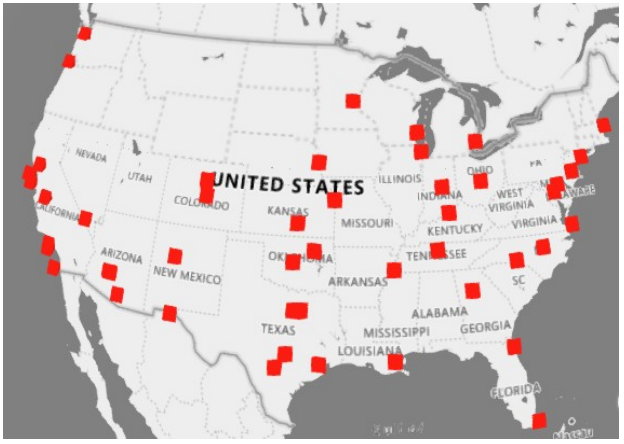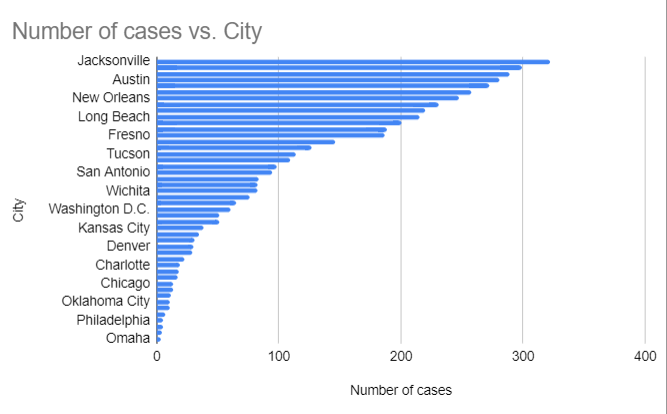Introduction
Each day, in each nation, state, and city across the world, there is a range of health problems. This week uses reported data that is plotted onto the map to provide a glimpse of the least and most affected regions of the United States (US) in which endemics have occurred during February, March, and April. Maps may offer visual help on the infection paths and progression permitting medical personnel to scheme defenses against future endemics. Data offers many elements of the required information, for example, the least and most likely age groups infected, and regions of higher exposure risk. Mapping information offers companies with mechanisms significant to formulate strategies for treatment and potential future prevention approaches (Brown, 2020). The Map in Figure 1 below was created utilizing the data set to offer a visual representation of the outbreak in the United States.


Cities (States) at Low Risk and High Risk
As the symbols map in Figure 1 demonstrates and the bar chart given in Figure 2, the virus is not restricted to one given region in the nation. Most cities have recorded cases of inflection; although, the five cities that have recorded the greatest exposure risks comprise Jacksonville at 322 cases, Miami at 299 cases, Phoenix at 289 cases, Austin at 281 cases, and Houston at 272 cases that were reported. Further, the five cities spotted in a similar way having the least exposure risk to the viral infection comprise Omaha with 3 cases, Virginia Beach with 4 cases, Philadelphia with 5 cases, Colorado Springs with 5 cases, and Indianapolis with 7 cases reported.
Areas of the Country with Low Risk and High Risk
Through a careful data review showed that the country’s areas with the lowest and highest risk differ. Occurrences are not restricted to one state, even though a blend of states was affected. In addition, situations differ, although, the data review mapped in Figure 1 above shows that the endemic is prevalent along the Coastal areas of the US in some of the most densely populated states, for example, Texas, California, and the East Coast States. Based on Figure 1, areas of the US having the lowest risk are the northern Midwest to the Northwest region. The figure depicts there were no viral infection cases reported in areas such as Idaho, Wyoming, Utah, Montana, South Dakota, and North Dakota.
After Evaluation of the Chart
After analysis of the information given, one may deduce that the endemic viral infection rate escalated monthly between February and April. In April, there was a substantial increase in infection. In rare cases inflection increases above what epidemiologists refer to as an epidemic, implying that the projected levels are seldom exceeding. An epidemic as per the CDC definition is an abrupt rise in the number of outbreaks surpassing what had been forecasted or what is anticipated according to the population of a given area. The data given may be a sign that the endemic might increase to epidemic level when the escalation in cases persists to increase at the same rate it is growing now. Figure 1 analysis also offers a visual that cases of the infection decline further away from the coastline in the Northern Midwest.
Information Analysis
Benefits of Data Usage in Healthcare Nursing Home Facilities
The selected healthcare facility is the Healthcare Center of Jacksonville, a nursing home in the city. The hospital with measures devised to help minimize the endemic, for example, maneuvering the available resources to areas that are in serious need may decrease the viral infection spread. Most long-term or skilled care nursing home facilities comprised people with an average age of 61 years and above. They are generally diagnosed with compromised or weakened immune systems needed more care and help than others in society (Brown, 2020). CDC has spotted them to be citizens at high risk of infection in population; hence, having the privilege to get extra care together with the first group receives vaccines.
Conflict of Interest
In most cases, conflicts of interest emerge in skilled nursing home facilities. Most of the spotted endemic in Figure 1 seems to align with popular vacation and tourist destinations. In the time of an endemic travel to specific areas must only happen out of necessity, for instance, work associated with guaranteeing a way of preventing the spread of the viral infection. Travelers may easily spread the infections unintentionally to others across the globe. The transmission may be reduced via restrictions on travel to affected regions (Brown, 2020). The data gathered only reveals reported cases across the United States, although the priority is prevention within the US and other nations.
Further, the conflict of interest area is the transport of infected people from skilled nursing homes to healthcare facilities. Because transport typically happens via the utilization of emergency vehicles, it places the personnel and any other people who use that vehicle at an escalated viral infection rate (Moncion et al., 2019). Taking precautionary actions that comprise utilization of emergency infection apparatus and sterilization of the applied vehicle may reduce the risk of spread to other people.
Ethical Considerations
They should often be at the medical healthcare providers’ forefront. When offering quality care, qualified nursing home facilities experience several ethical issues, for instance, end-of-life resolution-making problems comprising advanced care schemes and coercion, and lack of resources for qualified nursing personnel (Sperling, 2021). Qualified nursing home facilities experience the problems of how to resolve care for the growing complex patient populace.
Furthermore, some of the most probable and common ethical challenges experienced by qualified nursing home facilities comprise patients’ confidentiality served to comprise protection of their rights that include the right to privacy, and some violations in confidentiality, communication comprising patient care’s autonomy, and informed consent communication. The nursing home facilities experience problems, for instance, assuring that centrality is offered to fulfill the needs of the patient based on written protocols and policies (Sperling, 2021). In addition, facilities experience problems in association with the assignment of resources to fulfill the needs, and the possibility of one of the most significant that several facilities experience during the middle of an endemic is the staffing patterns that might adversely affect healthcare quality care services delivery to people (Jia et al., 2021). Medical healthcare practitioners, for instance, in skilled nursing home facilities focus when resolving ethical problems must be on reducing hazards and assuring that all parties’ requirements are considered when making resolutions.
Health Effects of Community
Usage of earlier given data throughout the study offers information on the positive influences of health effects on society. When medical healthcare providers study the effects that the endemic has and the influence that is established on society, both staff and health providers may use the data to create informed resolutions to help in the patient’s treatment. It assists healthcare providers in becoming aware of any adverse influences and ways of restricting further injury to patients and minimizing the further transmission of the viral infection. The data given revealed that there was a rise in the number of cases between February and April months with most of the effect that affects people ranging between those aged 0 to 18 years and 61 years and above (Kuebart & Stabler, 2020). The data revealed that the states affected most by viral infection are Florida, California, Arizona, and Texas.
Further, a decrease in viral infection may be achieved with more community awareness to inform them of effective precautionary measures that may be taken to minimize the transmission, for example, proper hygiene such as hand washing practices. States displaying a surge in viral infection spread may also collaborate with those depicting the lowest numbers of infections to consider what works for their societies and the way they may execute them in most affected communities (Kuebart & Stabler, 2020). The members of the community have a chance to create well-informed resolutions concerning their safety and health, executing best practices as per the information given by hospitals.
Conclusion
Healthcare facilities should spot any areas that pose a higher risk of viral infection transmission and spread. Calculation of the risk spotted as both low and high provides medical professionals with the required data on the recognition of consequences, threats, and susceptibilities. The use of resources to improve awareness of infection transmission, symptoms, and signs, as access to required demographics and resources have all been shown to help in reducing transmission. Hence, it is hoped that the data collected would help medical experts and facilities in effectively and efficiently controlling infection and managing those areas that display a substantial rise in endemics. It permits proper prevention and response approaches to minimize the risk of viral infection spread and transmission. Mapping infected areas provides insightful potential path forecasts to minimize spread before the escalated rise in confirmed positive cases.
References
Brown, R. B. (2020). Public Health Lessons Learned From Biases in Coronavirus Mortality Overestimation. Disaster Medicine and Public Health Preparedness, 14(3), 364 – 371. Web.
Jia, H., Chen, O., Xiao, Z., Xiao, J., Bian, J., & Jia, H. (2021). Nurses’ ethical challenges caring for people with COVID-19: A qualitative study. Nursing Ethics, 28(1), 33-45.. Web.
Kuebart, A., & Stabler, M. (2020). Infectious Diseases as Socio-Spatial Processes: The COVID-19 Outbreak In Germany. Journal of Economic and Human Geography, 1(2), 1-18. Web.
Moncion, K., Young, K., Tunis, M., Rempel, S., & Stirling, R. (2019). Effectiveness of hand hygiene practices in preventing influenza virus infection in the community setting: A systematic review. Canada Communicable Disease Report, 45(1), 12-23. Web.
Sperling, D. (2021). Ethical dilemmas, perceived risk, and motivation among nurses during the COVID-19 pandemic. Nursing Ethics, 28(1), 9-22. Web.